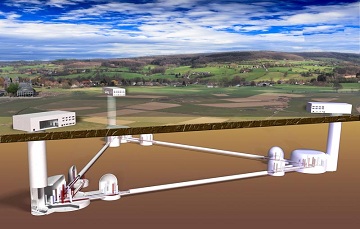At that time, relativity and the new perspective on gravity offered by Einstein’s theory was so controversial that the Nobel Prize Committee members chose to protect their reputations and felt that it would be appropriate to award Einstein the Nobel Prize for “his services to theoretical Physics, and especially for his discovery of the law of the photoelectric effect”. One hundred years later, the theory of relativity is part of second-year University curriculum and reputations are safe.
Classical astronomy relies on the fact that cosmic events generate electromagnetic radiation in different regions of the electromagnetic spectrum (radio waves, microwaves, infrared radiation, visible light, ultraviolet radiation, X-rays, and gamma rays). This electromagnetic radiation is recorded with telescopes or other instruments and the details of the astronomic events are revealed to observers. The limitations of the early ground astronomical observatories are quite obvious: the eyes of the astronomers were used as sensors and they were able to receive only the electromagnetic radiation passing through the atmospheric window. Many secrets have been revealed to us only after the telescope sensors were able to record data across all regions of the spectrum and when the astronomic observatories have been moved in orbit around Earth.
But the strength of our space telescopes is also their weakness… there are astronomical events that do not generate electromagnetic radiation, or to be more exact, they keep it for themselves. And the example is just beyond the event horizon: a black hole. This is where Einstein’s theory of relativity comes to the rescue. Even if the electromagnetic radiation cannot escape the gravitational grip of a black hole, gravitational waves can. A black hole cannibalizing another black hole will generate gravitational waves that cause distortions in the space-time.
The question is how to detect the gravitational waves. The first generation of gravitational wave detectors is already deployed, and the second generation is currently being designed by scientists. They are based on interferometers and the principle on which they rely is very simple: they detect tiny variations in the relative positions of sensors located far away from each other. The Advanced Laser Interferometer Gravitational Wave Observatory (LIGO), which is a first-generation instrument, consists in two perpendicular four-kilometer tubes in which LASER light enters through a splitter. Each tube has mirrors located at their ends so the light can bounce back and forth between the end points of the tubes many times. The two beams of light eventually return to the splitter and if the two tubes have different lengths (they are designed and built identical) the splitter will not be able to reconstruct the initial LASER beam.
Gravitational waves passing through the gravitational wave observatory would affect the two tubes in different ways so a photodetector exposed to the reconstructed LASER beam would record the variations. In order to validate such observations and rule out false signals caused by earthquakes, tides, and even human activity, LIGO consists of three interferometers.
A third-generation observatory, ten times more sensitive than the second-generation instruments, was proposed by a team of European scientists. This third-generation observatory is called the Einstein Telescope. Similar to LIGO, the Einstein Telescope will consist of three interferometers. An improvement of the new instrument is the ten-kilometer arms, and a cryogenic system that will cool the elements of the instrument so that the noise caused by molecular motion will not affect the measurements. In addition, the interferometers are located 150 meters underground and away from coast lines.
The project is supported by the European Commission and there are eight research institutions involved in the study and the conceptual design of the telescope. The design study project is organized in four working groups: WP1 (Site Identification), WP2 (Suspension Requirements), WP3 (Topology Identification), and WP4 (Astrophysics Issues).
We are witnessing the emergence of a new field of astronomy — Gravitational Wave Astronomy. You can find more details about Gravitational Wave Astronomy and the Einstein Telescope on the telescope home website.










 Subscribe to blog posts using RSS
Subscribe to blog posts using RSS










